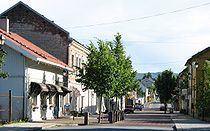Local time Sunday 5:43 PM | ||
 | ||
Weather 16°C, Wind W at 10 km/h, 46% Humidity | ||
Vestfossen is a village in the municipality of Øvre Eiker, in the county of Buskerud, Norway.
Contents
Map of 3320 Vestfossen, Norway
History
Vestfossen is a former industrial town with traditions dating back to the 16th century. At that time, the manor house known as Fossesholm became the center of a land collecting effort for the purpose of creating a large-scale sawmill industry. Later, other types of industry emerged. The most influential among them were the textile factory of Fredfos Uldvarefabrik and the Vestfossen Cellulose, a former paper company founded in 1886 as a pulp mill, which declared bankrupt in 1967.
An industrial crisis which occurred around 1970 lead to the fall of these factories, and large parts of the local industrial infrastructure was unused for a long time. After the year 2000, a cultural effort led to the establishment of several cultural institutions here, most notably the contemporary art gallery of Vestfossen Kunstlaboratorium founded by artist Morten Viskum. Vestfossen now calls itself "the capital of culture". As of 2008 Vestfossen had a population of 2,867 according to Statistics Norway.
Geography
Vestfosselva River runs through Vestfossen, flowing out from the two contiguous lakes Fiskumvannet and Eikern. Vestfosselva is the largest tributary of the Drammenselva. The Vestfossen waterfall is dammed and has a power station. On the lower side of the waterfall, the river continued to Hokksund, where it splits into two rivers, Nøstelva and Loeselva, both of which flow into the Drammenselva.
Fosseholm Manor House
Between 1541-1548, Peder Hanssøn Litle (c. 1500 – 1551), who served as captain as the Akershus Fortress, gained control of properties located on the lower part of the Drammen waterway. The water falls were bought with a view toward operating saw mills and establishing a lumber trade on a large scale. The estate remained within the Litle family until 1616 when Gunde Lange (1570–1645) acquired it and changed the name of the farm to Fossesholm Herregård around 1630.
In 1763, Jørgen von Cappelen (1715–1785) acquired Fossesholm. He expanded the estate and developed a magnificent set of buildings in rococo style inspired by great European manor houses. The Swedish painter Eric Gustav Tunmarck (1729–1789) decorated many of the interior walls with scenes from the farm environment. The good times for the Norwegian lumber trade came to an abrupt halt at the end of 1807 when Norway entered into war which effected the prime lumber market of Great Britain. In 1822 Fossesholm Manor was submitted for auction.
Amund Pedersen Fossesholm (1830–1930), who was the owner of the manor until his death, started a number of local business, including a brewery, sawmill and mill and Vestfossen Træmassefabrik. Fossesholm Manor including 22 acres of land was acquired in 1973 by the Eiker Historical Society.
